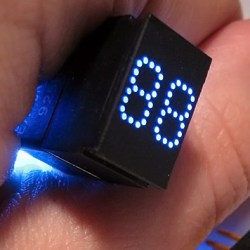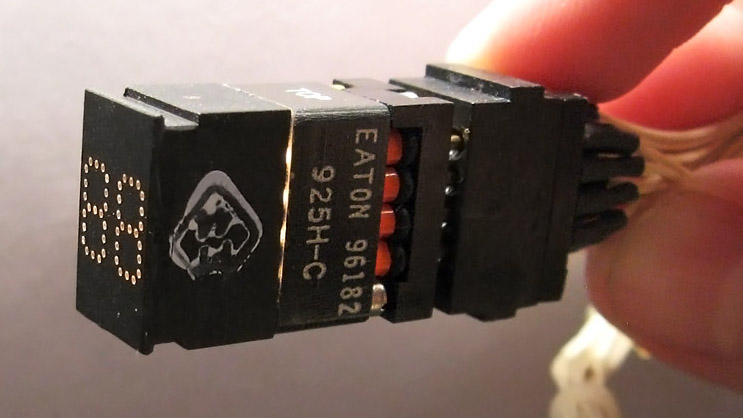 Back before LED technology came into its own, displays used incandescent bulbs. These vintage incandescent displays weren’t necessarily big; the Eaton 925H-C fiber optic display, for example, has numbers barely 7 mm tall and packs two of them into a tiny area. Of course, the depth of the display module itself is huge by today’s standards; those components have got to go somewhere, after all.
Back before LED technology came into its own, displays used incandescent bulbs. These vintage incandescent displays weren’t necessarily big; the Eaton 925H-C fiber optic display, for example, has numbers barely 7 mm tall and packs two of them into a tiny area. Of course, the depth of the display module itself is huge by today’s standards; those components have got to go somewhere, after all.
This particular device is, in [Industrial Alchemy]’s words, “[d]ripping with the spending excess that only a bottomless military budget can provide… the Eaton 925H-C may not be a practical device, but it is certainly an impressive one.”
The way the display works is this: individual incandescent bulbs light up fiber optic light guides, which terminate on the face of the display in small dots to make up a numerical display. With only fourteen bulbs, the dots we see here clearly aren’t individually addressable; the two digits are most likely broken up into seven segments each, with three dots making up each segment.

The sheer amount of workmanship in these displays is remarkable, and their design makes them easy to retrofit with LED technology instead of replacing the tiny incandescent lamps. In a stark contrast to all of the machined aluminum and gold plated contacts seen here in the Eaton 925H-C, take a look at this Soviet-era seven-segment incandescent display whose construction is far less sophisticated, but shows off its own clever engineering. We’ve also seen more modern DIY takes on the concept, using LED light sources and cured UV resin light pipes to get that vintage look to the displays.
















I’m not quite sure of the snark in the quote–I fail to see how it’s not practical. It’s a rather straightforward design that seems to do the job just fine. Gold plating? Common and absolutely needed for reliability (especially in hot and humid environments for instance.) The depth? Minus the connector it doesn’t seem all that deep considering it uses incandescent bulbs. Have you seen the size of “civilian grade, commercially-priced,” incandescent-lit numeric displays before LEDs?
Also, “over engineered” ?
It’s designed to last a long time, It’s serviceable and it’s a module that is reusable.
Here it is working decades after manufacture. It’s not in landfill.
To call it over engineered is a modern perspective where consumerism is fine, built-in obsolescence is fine, pollution is fine and destroying our planet is fine.
Wholeheartedly agree with both of you. The snarky comments are not justified.
Interesting, and beautifully made. Though it would satisfy the curiosity a bit more if we got a peek inside the back of the light guide/bezel part.
… why do I have this fuzzy memory that FranLab covered this? Maybe I’m just confusing it with some other display.
If she hasn’t I’m sure she’d love to. This does have Fran written all over it in any case.
She has covered the incandescent bulb based displays used in NASA’s Apollo era Mission Control, but not specifically this type to the best of my knowledge.
She kindof did, although it was a different model eaton indicator: https://youtu.be/C73gqTP5XI4
This is redundance at its best. Two bulbs per segment and two digits per device. This part is from an equipment which is supposed to operate also in the dark – or is dark inside – and is supposed to resist being hit hard. And it is supposed to be fixed fast without special training. I am talking about United States avionics, tanks and submarines monitoring equipment, 1960…1980 era, when the US$ was strong and bottomless budgets were serious business.
Imagine what we could do with that kind of bottomless budget and today’s tech. It’s amazing how fast we went to the moon, and yet we still don’t have EV batteries made of renewable material, laser mosquito defense in
widespread use, consumer mass spectrometry for pollution monitoring, etc.
Seems like half the big news these days starts at a university and languishes for a decade till some random
Beijing company or something figures out how to make it cheap without a mega research budget, and we don’t have many true tech megaprojects outside secret military stuff we don’t get to use as civilians.
I think it’s also about motivation. Back when a lot of designs like this were made we were either at war or in a cold war rush. Nothing motivates more than a mutually assured destruction race….
It is not all about budget… It’s also the whole political and cultural landscape. US wasn’t as politicalizing everything and anti-science as we have right now. I mean how difficult to priortize life over “freedumb” of not wearing a piece of cloth over your mouth hole?
Oh interesting. When you said “politicizing everything and anti-science” I was totally thinking of the “other side of the aisle” from what you intended, until you made a pun about people who don’t want to wear masks. Just illustrates how politically divided the USA is and how intolerant people are of those with opposing views. But I appreciate that here, people of different backgrounds share common interests.
Regarding “bottomless budgets” while there is a lot of money in military funding, and some of it is spent excessively, people are really jumping to conclusions in saying that something like this is over-engineered. When people’s lives may be depending on it functioning properly while under fire, it doesn’t seem over-engineered. But for a clock display on a VCR, yeah that would be ridiculous. It’s all in the context.
Also consider most government contracts are required to be awarded to the lowest bidder, technically acceptable. Imagine what the other guys might have come up with!
why would the millitary be interested in hippy batteries made out of soy, think about it, these are the same people who power their ships with reactors
How did you conclude that batteries made of renewable resources automatically mean soy or something hippy?
Actually nevermind. You’d have to be that close minded to make that sort of comment
14 bulbs = 2 digits X 7 segments per digit.
that person’s vision or math was redundant. thank you
Gotta agree with most of the comments. Better title would be “nicely engineered” or “what used to be standard engineering practice” or “when engineered properly” or some variation thereof.
Yeah, those goofy aviation engineers and their penchant for reliable, easily serviceable devices. Why can’t they just replace “over-engineered” with some slap-dash software patch and call it good enough? I mean, if they do that they probably don’t even need to let the FAA or NTSB have oversight or anything. I mean, what is the worst thing that could happen?
I would also guess that the reliability, or at least ability to take it apart with a screwdriver and change a bulb, without any prior knowledge or special equipment, would pretty quickly offset the initial engineering and development cost. That is an assumption though. Plus if one bulb fails, the whole thing doesn’t go dark.